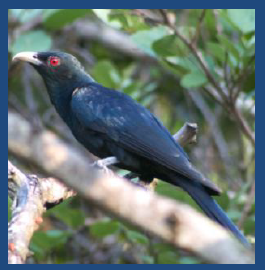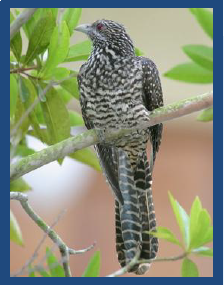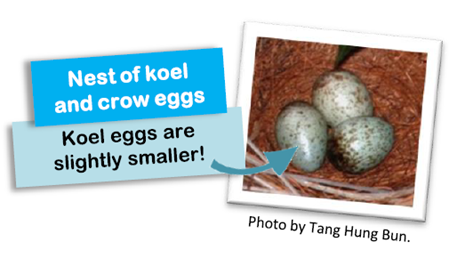
Male Asian Koels: Glossy blue-black plumage, crimson irises, long tail, pale green beak, and grey legs and feet.
Photo by David Tan

Female Asian Koels: Dark brown upperparts and light brown underparts; body is heavily spotted and streaked in white and rufous.
Photo by Tsang Kwok Choong
What are they?
The Asian Koel (Eudynamys scolopaceus) is a large cuckoo bird. It is a brood parasite that lays its eggs in the nests of other birds, which will provide parental care until the young Koel is ready to fly. In Singapore, the host is predominantly the House Crow (Corvussplendens).
Distribution & Habitat
Asian Koels are found in China, South Asia and Southeast Asia. In Singapore, it can be found in secondary forests, parks, and low-density urban areas, feeding mainly on fruits and berries.
Behaviour
The Asian Koel is more often heard than seen, especially during its breeding season (roughly every 3 months throughout the year, following the house crow’s breeding cycle). The Koel makes a variety of calls, including the distinctively loud, repetitive, high- pitched ‘ku-oo’ mating calls from dawn, and can sometimes be heard till night.
Important Ecological Roles
Control of the house crow population
The Asian Koel is a protected species under the Wildlife Act. As a brood parasite, the Asian Koel deposits its eggs in the unattended nest of a house crow, sometimes removing one of the host’s eggs in the process. The Koel chick hatches first and may force the host’s eggs or chicks out of the nest. Therefore, Koel brood parasitism reduces the crow’s reproduction success and keeps its population in check.

What should you do if you are affected by the Asian Koels?
NParks is working with NEA and premise managements to prune trees, and remove crows’ nests and food sources to discourage Asian Koels from roosting in residential areas.
If you need any assistance, you can contact us through our online feedback form at https://www.avs.gov.sg/feedback. Alternately, you can approach your town council or condominium management for assistance.
While there are Singaporeans who have been inconvenienced by calls of the Asian Koel, there are also others who enjoy the presence of such wildlife in our environment. We seek your understanding with regard to the management of the Asian Koel population.
References from An annotated checklist of the birds of Singapore (2007) and singaporebirds.net